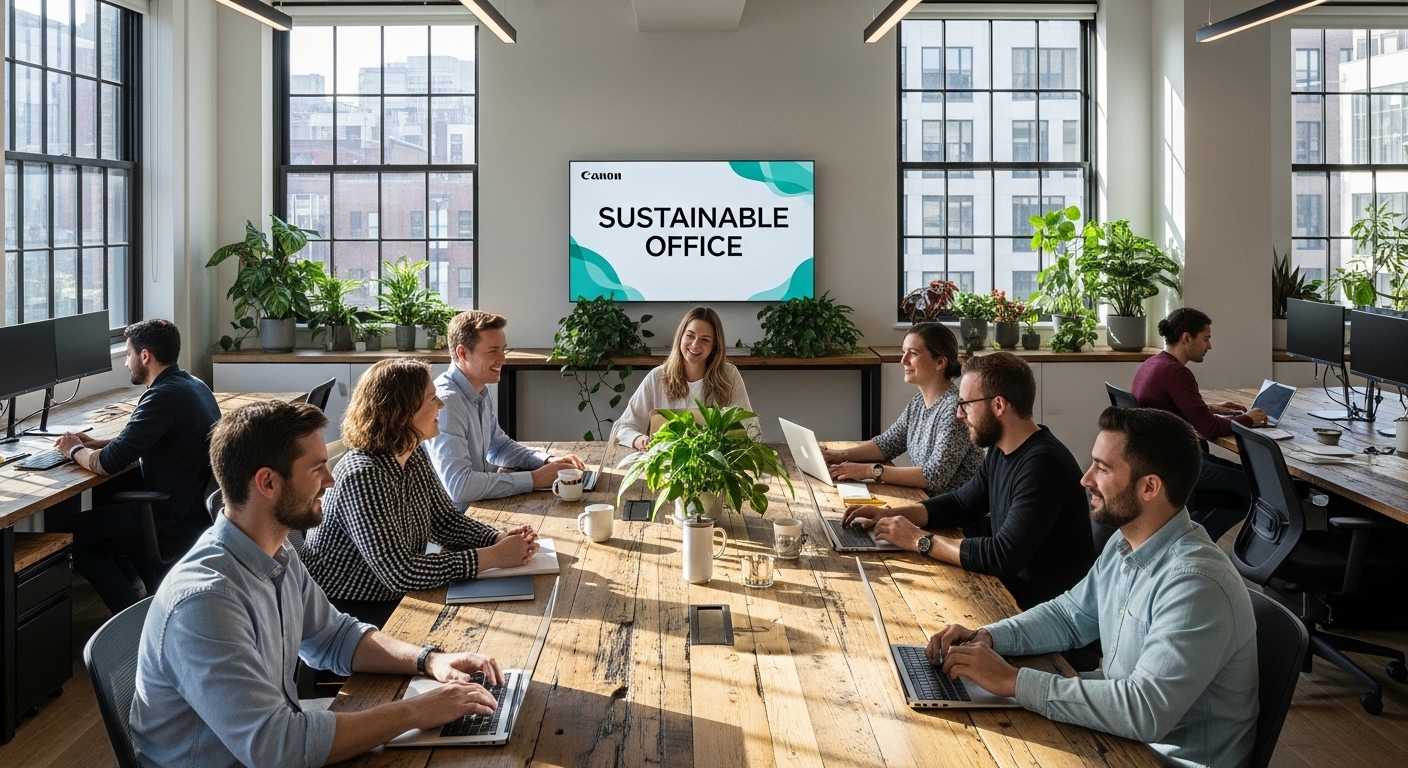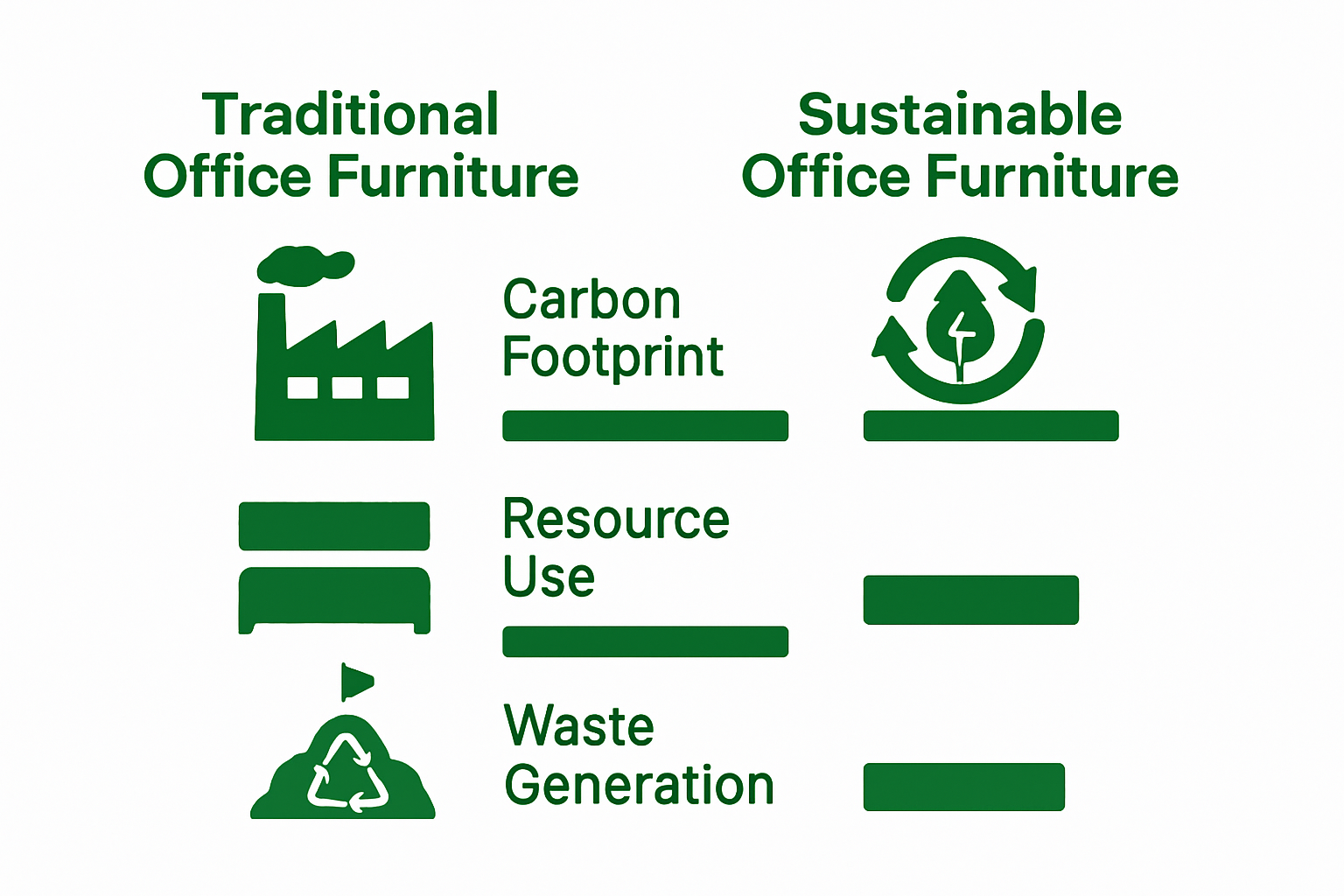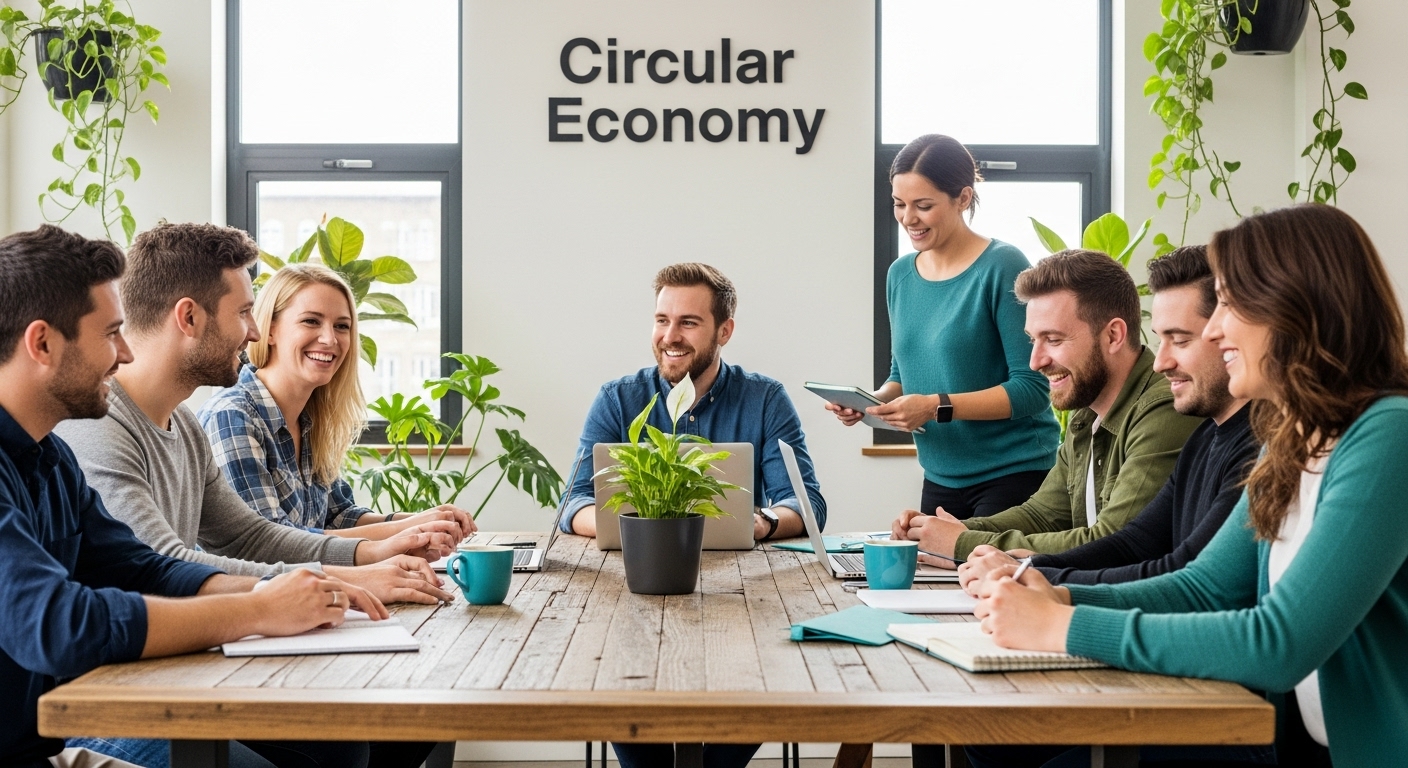Understanding Sustainable Office Furniture: Benefits and Impact
Sep 22, 2025
Understanding Sustainable Office Furniture: Benefits and Impact

Sustainable office furniture is changing how South Africans think about their workspaces and the planet. It sounds like a small shift but some government programmes have turned invasive alien plants into over 300,000 eco-friendly school desks. Most folks expect eco choices to be about sacrifice or higher costs. Yet these sustainability moves are creating jobs, cleaning up the environment, and building healthier offices all at once.
Table of Contents
- What Is Sustainable Office Furniture And Its Components?
- Why Sustainable Office Furniture Matters For The Environment
- How Sustainable Office Furniture Works To Reduce Impact
- Key Concepts In Choosing Sustainable Office Furniture
- Real-World Examples Of Sustainable Office Furniture In Use
Quick Summary
| Takeaway | Explanation |
|---|---|
| Prioritize eco-friendly materials | Use renewable and recycled materials such as bamboo and reclaimed wood for furniture production. |
| Implement energy-efficient manufacturing | Adopt techniques that reduce carbon emissions and energy consumption during the furniture production process. |
| Focus on durability and longevity | Select furniture designed to last, minimizing waste and the need for frequent replacements. |
| Consider lifecycle and circular economy | Choose products that can be recycled or repurposed, contributing to sustainable practices. |
| Adopt ethical manufacturing practices | Ensure fair labor practices and safety standards in the production of sustainable furniture. |
What is Sustainable Office Furniture and Its Components?
Sustainable office furniture represents a comprehensive approach to designing, manufacturing, and utilizing workplace furniture that minimizes environmental impact while maximizing social and economic benefits. According to the Sustainable Furnishings Council, sustainability involves creating products that reduce negative environmental, health, and social consequences throughout their entire lifecycle.
Key Components of Sustainable Office Furniture
Sustainable office furniture is not just about the end product, but the entire ecosystem of design, materials, manufacturing, and disposal. The primary components include:
- Eco-friendly Materials: Using renewable, recycled, or responsibly sourced materials like bamboo, reclaimed wood, recycled metals, and low-impact plastics
- Energy-efficient Manufacturing: Implementing production processes that minimize carbon emissions and reduce energy consumption
- Durability and Longevity: Creating furniture designed to last longer, reducing waste and the need for frequent replacements
Material Considerations and Environmental Impact
The composition of sustainable office furniture goes beyond simple material selection. As detailed by the GSA Sustainable Facilities Tool, composite wood products like particleboard and plywood can contribute to sustainability by utilizing wood waste from production facilities. However, manufacturers must carefully examine adhesives to ensure they are low in volatile organic compounds (VOCs) and free from harmful chemicals like urea-formaldehyde.
For businesses looking to understand more about sustainable materials, our guide on office furniture materials provides comprehensive insights into making environmentally responsible choices.
Key environmental benefits of sustainable office furniture include:
- Reduced carbon footprint
- Conservation of natural resources
- Minimized waste in landfills
- Support for circular economy principles
By prioritizing sustainable office furniture, organizations can create workspaces that are not only functional and aesthetically pleasing but also environmentally responsible and socially conscious.
Why Sustainable Office Furniture Matters for the Environment
Sustainable office furniture plays a critical role in addressing global environmental challenges by reducing ecological footprints and promoting responsible consumption. The environmental impact of traditional furniture manufacturing is significant, with substantial resource depletion, carbon emissions, and waste generation that contribute to environmental degradation.
Carbon Footprint and Resource Conservation
Traditional office furniture production involves extensive resource extraction, energy-intensive manufacturing processes, and substantial waste generation. Sustainable office furniture directly counteracts these environmental challenges by implementing innovative strategies that minimize ecological impact. According to the Department of Environmental Affairs’ Green Fund, transitioning to sustainable practices supports a low-carbon, resource-efficient development pathway that delivers critical environmental benefits.
Key environmental advantages include:
- Reducing greenhouse gas emissions during production
- Minimizing raw material extraction

- Promoting circular economy principles
- Decreasing waste sent to landfills
Innovative Sustainable Practices in Furniture Manufacturing
South African initiatives demonstrate remarkable approaches to sustainable furniture production. The Eco Furniture project, funded by the Department of Environmental Affairs, exemplifies how innovative thinking can transform environmental challenges into opportunities. By repurposing invasive alien vegetation into eco-friendly furniture, these initiatives create jobs while simultaneously addressing environmental concerns.
Businesses interested in exploring sustainable furniture trends can learn more about the latest office furniture design innovations that prioritize environmental responsibility.
Moreover, sustainable office furniture supports broader environmental goals by:
- Encouraging responsible material sourcing
- Supporting renewable resource utilization
- Promoting energy-efficient manufacturing processes
- Creating products with extended lifecycle and reduced environmental impact
By choosing sustainable office furniture, organizations demonstrate environmental stewardship, contribute to global sustainability efforts, and create workspaces that reflect a commitment to ecological responsibility.
How Sustainable Office Furniture Works to Reduce Impact
Sustainable office furniture reduces environmental impact through a holistic approach that addresses multiple stages of product lifecycle, from material sourcing to manufacturing, usage, and eventual disposal. The strategic implementation of sustainable practices transforms traditional furniture production into an environmentally responsible process.
Material Selection and Responsible Sourcing
The first critical step in reducing environmental impact involves carefully selecting and sourcing materials. Sustainable office furniture manufacturers prioritize:
- Recycled materials like reclaimed wood and metal
- Rapidly renewable resources such as bamboo and cork
- Materials with low embodied carbon
- Locally sourced components to minimize transportation emissions
Research from the University of Pretoria’s carbon impact study highlights how strategic material selection can significantly reduce greenhouse gas emissions in office environments.
Manufacturing and Production Efficiency
Sustainable office furniture manufacturers implement advanced techniques to minimize environmental footprint during production. Energy-efficient manufacturing processes play a crucial role in reducing overall carbon emissions. These include:
- Using renewable energy sources in production facilities
- Implementing water conservation techniques
- Minimizing waste through precise cutting and recycling techniques
- Reducing chemical usage in manufacturing processes
For businesses interested in understanding how durability contributes to sustainability, our comprehensive guide on furniture durability offers valuable insights.
Lifecycle and Circular Economy Approach
The ultimate goal of sustainable office furniture is creating products with extended lifecycles that can be recycled, repurposed, or biodegraded. The South African Eco-Furniture Project exemplifies this approach by transforming invasive alien vegetation into eco-friendly furniture, demonstrating how circular economy principles can be practically implemented.
By prioritizing sustainable design, businesses can significantly reduce their environmental impact, create more responsible workspaces, and contribute to global sustainability efforts.
Key Concepts in Choosing Sustainable Office Furniture
Choosing sustainable office furniture requires a comprehensive understanding of environmental, social, and economic factors that extend far beyond traditional purchasing considerations. Sustainable furniture selection is a strategic decision that impacts workplace wellness, environmental responsibility, and long-term organizational performance.
Material Composition and Environmental Credentials
The foundation of sustainable office furniture lies in its material composition and verifiable environmental credentials. Businesses must evaluate furniture based on critical sustainability indicators:
- Percentage of recycled content
- Renewable resource origin
- Low volatile organic compound (VOC) emissions
- Certifications from recognized environmental standards bodies
According to the Green Building Council South Africa, certified green building practices play a crucial role in mitigating climate change and improving indoor environmental quality, with furniture selection being a significant component of this approach.
Lifecycle Assessment and Durability
Sustainable office furniture goes beyond initial material selection to encompass comprehensive lifecycle assessment. Key considerations include:
- Expected product lifespan
- Potential for repair and refurbishment
- Ease of component replacement
- End-of-life recyclability or biodegradability
Businesses seeking innovative design solutions can explore the latest trends in office furniture design that balance sustainability with aesthetic and functional requirements.
Ethical Manufacturing and Social Responsibility
True sustainability extends beyond environmental considerations to include ethical manufacturing practices and social responsibility. Responsible businesses should investigate:
- Fair labor practices in manufacturing
- Worker safety standards
- Local economic impact of production
- Transparency in supply chain management
By adopting a holistic approach to sustainable office furniture selection, organizations can create workspaces that not only minimize environmental impact but also contribute positively to social and economic ecosystems.
To clarify the main criteria to consider when choosing sustainable office furniture, the following table summarises the key concepts and how each contributes to workplace sustainability in South Africa.
| Key Concept | Description |
|---|---|
| Material Composition | Use of recycled, renewable, or responsibly sourced materials to minimise environmental impact. |
| Environmental Credentials | Verification via certifications and adherence to green building standards. |
| Lifecycle Assessment | Evaluation of environmental impact across the product’s lifespan, from production to disposal. |
| Durability and Longevity | Focus on extended product lifespan, repairability, and reduced need for replacements. |
| Ethical Manufacturing | Fair labour practices, worker safety, and local economic impact are prioritised. |
| Social Responsibility | Ensuring positive community effects through responsible sourcing and social upliftment. |
Real-World Examples of Sustainable Office Furniture in Use
Sustainable office furniture is transforming workspaces across South Africa, demonstrating practical applications of environmental responsibility and innovative design. These real-world examples showcase how organizations are integrating sustainable furniture solutions to create more eco-conscious work environments.
Government and Public Sector Initiatives
The South African government has been at the forefront of sustainable furniture implementation. The Department of Environmental Affairs’ Eco-Furniture Programme stands out as a remarkable example, repurposing invasive alien plants to manufacture eco-friendly school desks. This initiative not only addresses environmental challenges but also creates economic opportunities for local communities.
Key achievements of government sustainable furniture programs include:
- Reducing invasive plant populations
- Creating jobs in furniture manufacturing
- Providing affordable, sustainable furniture for educational institutions
- Demonstrating circular economy principles in practice
Corporate Sustainability Strategies
Leading South African businesses are increasingly adopting sustainable office furniture as part of their corporate social responsibility strategies. Companies are moving beyond traditional procurement to prioritize environmentally responsible furniture solutions. Organizations are implementing comprehensive approaches that consider:
- Carbon footprint of furniture production
- Long-term durability and lifecycle assessment
- Employee wellness and ergonomic design
- Local manufacturing and reduced transportation emissions
For businesses looking to explore innovative design approaches, our guide on office furniture trends offers valuable insights into sustainable workspace solutions.
Small-Scale Manufacturing and Economic Impact
Local initiatives like Lesomo Trading and Projects, supported by the National Youth Development Agency, demonstrate how sustainable furniture production can drive economic empowerment. These small-scale manufacturers are creating durable, environmentally responsible furniture while supporting local employment and skills development.
By embracing sustainable office furniture, organizations contribute to a broader ecosystem of environmental responsibility, economic development, and innovative design that extends far beyond traditional workplace furnishing approaches.

Ready to Transform Sustainability into a Workplace Advantage?
If you are facing the challenge of reducing your office’s environmental footprint while creating a healthier and more inspiring workspace, Office Stock is here for you. The article highlighted a real need for furniture that is both eco-friendly and built to last. Businesses want to cut carbon emissions and waste, all while supporting employee wellbeing. You deserve solutions that help you achieve these goals without compromise.

Act now and browse Office Stock’s premium office furniture range to discover quality desks, ergonomic chairs, and storage that meet modern sustainable standards. Learn how our products support circular economy principles and responsible sourcing by visiting our insights on top trends in office furniture design or get details on durability in office furniture.
Make your next office upgrade sustainable and stylish. Start building a greener workspace with Office Stock today.
Frequently Asked Questions
What materials are commonly used in sustainable office furniture?
Sustainable office furniture is typically made from eco-friendly materials such as bamboo, reclaimed wood, recycled metals, and low-impact plastics, ensuring a reduced environmental impact.
How does sustainable office furniture help reduce carbon emissions?
Sustainable office furniture contributes to lowering carbon emissions through energy-efficient manufacturing processes, responsible material sourcing, and promoting products designed to last longer, which minimizes waste.
What is the lifecycle assessment in the context of sustainable office furniture?
Lifecycle assessment evaluates the environmental impact of office furniture throughout its entire lifespan, from raw material extraction and manufacturing to usage, recycling, and disposal, ensuring that products are sustainable from start to finish.
How does choosing sustainable office furniture benefit employee wellness?
Sustainable office furniture is often designed with ergonomic principles in mind, which can improve employee comfort and productivity while creating a healthier work environment conducive to overall wellness.
Recommended
- Understanding Why Invest in Quality Office Furniture - Office Stock
- Durability in Office Furniture: Guide for South African Businesses 2025 - Office Stock
- Top Trends in Office Design: Furniture That Inspires - Office Stock
- 8 Essential Benefits of Multi-Functional Office Furniture - Office Stock
- Nachhaltigkeit im Büro: Verständliche Erklärungen für Unternehmen | ooliv - Ihre Werbeagentur
- 7 Types of Sustainable Materials for Eco-Friendly Living – The Cork Store
